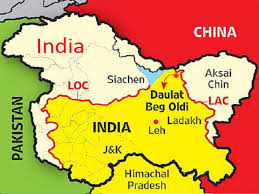Today’s Current Affairs: 26th April 2025 for UPSC IAS exams, State PSC exams, SSC CGL, State SSC, RRB, Railways, Banking Exam & IBPS, etc
Table of Contents
Central Board of Indirect Taxes and Customs : In News

In line with the Union Budget 2025–26, the Central Board of Indirect Taxes and Customs (CBIC) has introduced major trade facilitative measures for Air Cargo and Transhipment to enhance logistics efficiency and simplify customs procedures.
- CBIC is part of the Department of Revenue, under the Ministry of Finance.
- It administers:
- Customs, Central Excise, CGST, IGST, and Narcotics (where applicable).
- Policy formulation related to levy and collection of indirect taxes.
- Custom Houses, Excise & GST Commissionerates, and Revenue Laboratories.
- CBIC manages customs at: International Airports, Seaports, Air Cargo Stations, ICDs, LCSs, CFSs, and SEZs
- The CBIC is headed by a Chairman, supported by Chief Commissioners and Director Generals across various zones.
- It also operates a GST Intelligence Wing to monitor and prevent tax evasion.
National Industrial Corridor Development Programme:

NICDC was honoured with the Udyog Vikas Award at the Udyog Vikas event organised by Janmabhumi Daily in Kerala.
- NICDP is India’s most ambitious infrastructure initiative aimed at developing new industrial cities as “Smart Cities”, integrating next-generation technologies across infrastructure sectors.
- National Industrial Corridor Development Corporation (NICDC) is the nodal agency managing the programme.
- NICDP is designed to attract investments from both large anchor industries and Micro, Small, and Medium Enterprises (MSMEs), acting as a catalyst for achieving the Government’s goal of $2 trillion in exports by 2030.
- Newly sanctioned industrial areas under NICDP include: Khurpia (Uttarakhand), Rajpura-Patiala (Punjab), Dighi (Maharashtra), Palakkad (Kerala), Agra and Prayagraj (Uttar Pradesh), Gaya (Bihar), Zaheerabad (Telangana), Orvakal and Kopparthy (Andhra Pradesh), and Jodhpur-Pali (Rajasthan).
- These projects are closely aligned with the PM GatiShakti National Master Plan, ensuring integrated, seamless multi-modal connectivity across the country.
- The Palakkad Industrial Smart City, spanning 1,710 acres across Pudussery Central, Pudussery West, and Kannambra, is set to reshape Kerala’s industrial landscape.
No Phenotype Data Details in Genome India’s Proposal Call:

The Department of Biotechnology (DBT) had initiated a proposal call for ‘Translational Research using GenomeIndia data’ without disclosing crucial information about the available phenotype data, causing concerns among researchers across India.
- The project successfully collected blood samples and associated phenotype data from over 20,000 individuals belonging to 83 population groups, comprising 30 tribal and 53 non-tribal populations spread across India.
- Preliminary findings based on the genetic data of 9,772 individuals were published in the journal Nature Genetics on April 8, 2025.
- The collected phenotype data included anthropometric measurements such as height, weight, hip circumference, waist circumference, and blood pressure.
- From the blood samples, complete blood counts and biochemical data such as glucose levels, lipid profiles, liver function, and kidney function tests were measured.
- Phenome India-CSIR Health Cohort Knowledgebase (PI-CheCK) is an initiative launched by the Council of Scientific and Industrial Research (CSIR) on December 7, 2023.
- The main objective of the project is to develop India-specific risk prediction models for cardio-metabolic diseases including diabetes, liver diseases, and cardiac diseases.
- It is India’s first-ever pan-India longitudinal health monitoring study focused specifically on cardio-metabolic health.
- Participants include around 10,000 individuals—primarily CSIR employees, pensioners, and their spouses—from across 17 states and 24 cities.
- Collected data includes clinical questionnaires, lifestyle and dietary habits, anthropometric measurements, imaging and scanning data, and extensive biochemical and molecular data.
- This study is crucial for understanding how ethnic diversity and lifestyle patterns unique to India influence the risk and incidence of cardio-metabolic disorders.
- Through this project, CSIR is promoting a Predictive, Personalised, Participatory, and Preventive (P4) healthcare model suited to Indian genetic and phenotypic profiles.
3D Microscope:

For the first time, the Indian Army’s Department of Ophthalmology at Army Hospital (Research and Referral), New Delhi, has successfully performed Minimally Invasive Glaucoma Surgery (MIGS) using a 3D Microscope.
- A microscope is an instrument that magnifies small objects, making them visible to the naked eye by bending (refracting) light rays through curved lenses.
- The most commonly used microscopes are optical microscopes, where visible light is focused through lenses to create an enlarged image.
- A 3D microscope produces images with depth information (X, Y, and Z axes), allowing researchers to visualize and measure the topography, volume, and internal structures of samples.
- Unlike traditional light microscopes, which provide flat, 2D images, 3D microscopes use advanced optical, electron, or computational techniques to capture and reconstruct three-dimensional data.
- This is particularly useful for studying complex biological or environmental samples, such as soil microbes, aquatic organisms.
- The 3D Microscope uses advanced three-dimensional visualisation, assisting in complex eye surgeries such as treatment for squint, cataract, corneal diseases, glaucoma, and retinal conditions.
- It employs special 3D polarisation glasses for surgeons and a 55-inch 4K ultra-HD display.
- Key advantages include:
- Reduced surgical time and lower complication rates compared to conventional microscopes.
- Decreased endoilluminator power requirements, thereby reducing photo-toxicity risks.
- Ease of performing surgeries in complex and rare cases.
Mahuadanr Wolf Sanctuary:

The Mahuadanr Wolf Sanctuary, located in Latehar district of Jharkhand, holds the distinction of being India’s first and only wolf sanctuary
- Mahuadanr Wolf Sanctuary, located in the Latehar district of Jharkhand, is India’s first and only wolf sanctuary, dedicated to the conservation of the Indian grey wolf (Canis lupus pallipes).
- The sanctuary, spread over approximately 63 square kilometers, was declared in 1976 specifically for the protection of the Indian wolf population.
- Mahuadanr Wolf Sanctuary is an integral part of the Palamau Tiger Reserve.
- The wildlife of the sanctuary includes species such as spotted deer, wild boar, hyena, bear, and notably, the Indian wolf.
- The Indian grey wolf is a subspecies of the grey wolf found across Southwest Asia and the Indian subcontinent.
- It inhabits scrublands, grasslands, and semi-arid agroecosystems and thrives in warmer temperatures.
- Unlike other wolf subspecies, it lives in smaller packs and is less vocal, being primarily nocturnal and hunting from dusk to dawn.
- Conservation Status:
- IUCN Red List: Endangered (Indian population estimated between 2,000–3,000 individuals).
- CITES: Listed in Appendix I, indicating the highest level of international protection.
- Wildlife Protection Act, 1972: Included under Schedule I, granting maximum legal protection in India.
Line of Control:

Pakistan violated the ceasefire along the Line of Control in the Kashmir Valley by resorting to unprovoked firing, a defence official said recently and added the army responded appropriately.
- The LoC is the de facto military boundary between India and Pakistan in the region of Jammu and Kashmir.
- It is not an international boundary but a ceasefire line that was established after the 1947-48 India-Pakistan war over Kashmir.
- Then called the Ceasefire Line (CFL), it was redesignated as the “Line of Control” following the Simla Agreement, which was signed on 3 July 1972, following the 1971 Indo-Pakistan war.
- The LoC stretches about 740 kilometers, from the region of Ladakh in the north down to the Poonch district in the south.
- It is heavily militarized, with frequent skirmishes and exchanges of fire between Indian and Pakistani forces.
- On the Indian side of the LoC comes a part of Jammu and Kashmir and Ladakh. On the Pakistani side comes the part of Pakistan Occupied Kashmir (POK), Gilgit, and Baltistan.
- The LoC is different from the International Border (IB), which is the officially recognized border between India and Pakistan elsewhere.
StormBreaker Glide Bomb:

US fighter jets appear to be using advanced “StormBreaker” precision glide bombs in combat against the Houthis, part of the intense bombing campaign against the Iran-backed rebels.
- The Stormbreaker, designated as the GBU-53/B and also known as the Small Diameter Bomb II (SDB-II), is an American air-launched, precision-guided glide bomb developed by Raytheon.
- It is designed for all-weather precision strikes against both stationary and moving targets.
- The weapon weighs 93 kg, measures 1.76 meters in length, and has a diameter ranging from 15 to 18 cm.
- It features a multi-mode guidance system that combines millimeter-wave radar, uncooled infrared imaging, and a digital semi-active laser.
- Its GPS/INS navigation system allows for real-time in-flight target updates, enhancing adaptability to evolving mission requirements.
- It incorporates TacNet Data Link (DL) technology, enabling weapon-to-weapon collaboration.
- This system facilitates Automatic Target Recognition (ATR) to identify and engage tracked or wheeled vehicles.
- It features a multi-effects warhead that enhances lethality against a range of targets.
- The weapon, which combines blast, fragmentation, and shaped charge modes, guarantees decisive outcomes with each attack, efficiently eliminating threats on the battlefield.
- It can strike moving targets at a range of 45 miles and stationary targets at a maximum range of 69 miles.
Anaemia : Recent Study

According to a recent study conducted on women in the UK, being anaemic during pregnancy could be linked to a 47 percent higher chance of the child having a heart condition at birth.
- Anemia is a problem of not having enough healthy red blood cells or hemoglobin to carry oxygen to the body’s tissues.
- Hemoglobin is a protein found in red cells that carries oxygen from the lungs to all other organs in the body.
- Having anemia can cause tiredness, weakness, and shortness of breath.
- There are many forms of anemia. Each has its own cause.
- Some types of anemia are inherited, but people may also acquire or develop the condition during their lifetimes.
- WHO estimates that 40% of children 6–59 months of age, 37% of pregnant women, and 30% of women 15–49 years of age worldwide are anaemic.
- Anaemia can be short-term or long-term. It can range from mild to severe.
- Severe anemia can be life-threatening. This condition may also be a symptom of serious conditions like
- A common type of anemia is iron-deficiency anaemia, which is usually caused by not eating or absorbing enough iron, or by losing blood.
- Treatments for anemia might involve taking supplements or having medical procedures.
- Eating a healthy diet might prevent some forms of anemia.
Continental Shelf:

India has increased its claim in the Central Arabian Sea, as part of its ‘extended continental shelf’ by nearly 10,000 sq.km but also modified an earlier claim to avoid a long-standing dispute with Pakistan over the maritime boundary between the two countries.
- Continental Shelf is the edge of a continent that lies under the ocean.
- It is the extension of a coastal State’s land territory under the sea.
- It extends from the coastline of a continent to a drop-off point called the shelf break.
- From the break, the shelf descends toward the deep ocean floor in what is called the continental slope.
- The actual boundary of a continent is not its coastline, but the edge of the continental shelf.
- Over many millions of years, organic and inorganic materials form continental shelves.
- Inorganic material build up as rivers carried sediment—bits of rock, soil, and gravel—to the edges of the continents and into the ocean.
- These sediments gradually accumulate in layers at the edges of continents.
- Organic material, such as the remains of plants and animals, also accumulate.
- The widths of the continental shelves vary.
- Most continental shelves are broad, gently sloping plains covered by relatively shallow water. Water depth over the continental shelves averages about 60 meters (200 feet).
- Sunlight penetrates the shallow waters, and many kinds of organisms flourish—from microscopic shrimp to giant seaweed called kelp.
- Ocean currents and runoff from rivers bring nutrients to organisms that live on continental shelves.
- Plants and algae make continental shelves rich feeding grounds for sea creatures.
- The shelves make up less than 10 percent of the total area of the oceans.
- In some places, deep canyons and channels cut through the continental shelves.
- Little light penetrates these submarine canyons, and they are sometimes the least-explored areas of continents.
- Extended Continental Shelf geopolitically, under the United Nations Convention on the Law of the Sea (UNCLOS), coastal countries have special rights over the continental shelf for exploring and exploiting natural resources up to 200 nautical miles (exclusive economic zone).
- In addition to this, such States can make claims for more area in the ocean provided they can scientifically establish to a UN body, called the Commission on the Limits of the Continental Shelf (CLCS), that this claimed area extends unbroken from their landmass all the way to the seabed.
- All of this oceanic area is considered part of a country’s extended continental shelf.
- This gives them rights to commercially mine for valuable minerals, polymetallic nodules, and oil reserves.
China Has Tested A Revolutionary Type Of Hydrogen Bomb:
China has tested a revolutionary type of hydrogen bomb that functions without traditional fissile materials like uranium or plutonium. Instead, it uses advanced fusion techniques such as magnesium hydride-based fusion, raising serious concerns about arms control, international law, and global security. This advancement could potentially redefine how nuclear weapons are perceived and regulated in modern warfare.
Anant Ambani Appointed Executive Director of Reliance Industries Ltd:
The board of Reliance Industries Ltd (RIL) has approved the appointment of Anant Ambani as the Executive Director of the company for a term of five years, effective from May 1, 2025. This marks a major step in the generational leadership transition within the conglomerate, making Anant the first among the Ambani siblings to assume an executive role in the parent company.
Payal Kapadia Receives Prestigious French Honour:
Payal Kapadia, a Mumbai-based filmmaker, has received the prestigious ‘Officier dans l’Ordre des Arts et des Lettres’ (Officer of the Order of Arts and Letters) from the French Government. Payal Kapadia’s success story continues to unfold as she receives a significant accolade from France, acknowledging her exceptional contribution to cinema. The filmmaker was celebrated at a ceremony at the French Consulate in Mumbai, where she was conferred with the ‘Officer of the Order of Arts and Letters’.
Kailash Mansarovar Yatra 2025:
The Kailash Mansarovar Yatra (KMY) is a significant annual pilgrimage symbolizing deep religious and cultural ties between India and China. It holds immense importance for Hindus, Buddhists, Jains, and followers of the Bon religion. Circumambulating Mount Kailash is believed to bring spiritual merit, and bathing in Lake Mansarovar is thought to cleanse one’s sins. The pilgrimage was suspended in 2020 due to the COVID-19 pandemic and border tensions.
SEBI Revises Cut-Off Timing for Overnight Mutual Funds:
The revised timings aim to support SEBI’s upstreaming framework introduced in December 2023, ensuring better fund security and operational alignment across the ecosystem. The Securities and Exchange Board of India (SEBI) has revised the cut-off timing for redemption in overnight and liquid mutual fund schemes, effective June 1, 2025. This change is a part of SEBI’s broader initiative to enhance the safety of client funds held with brokers and clearing members.




